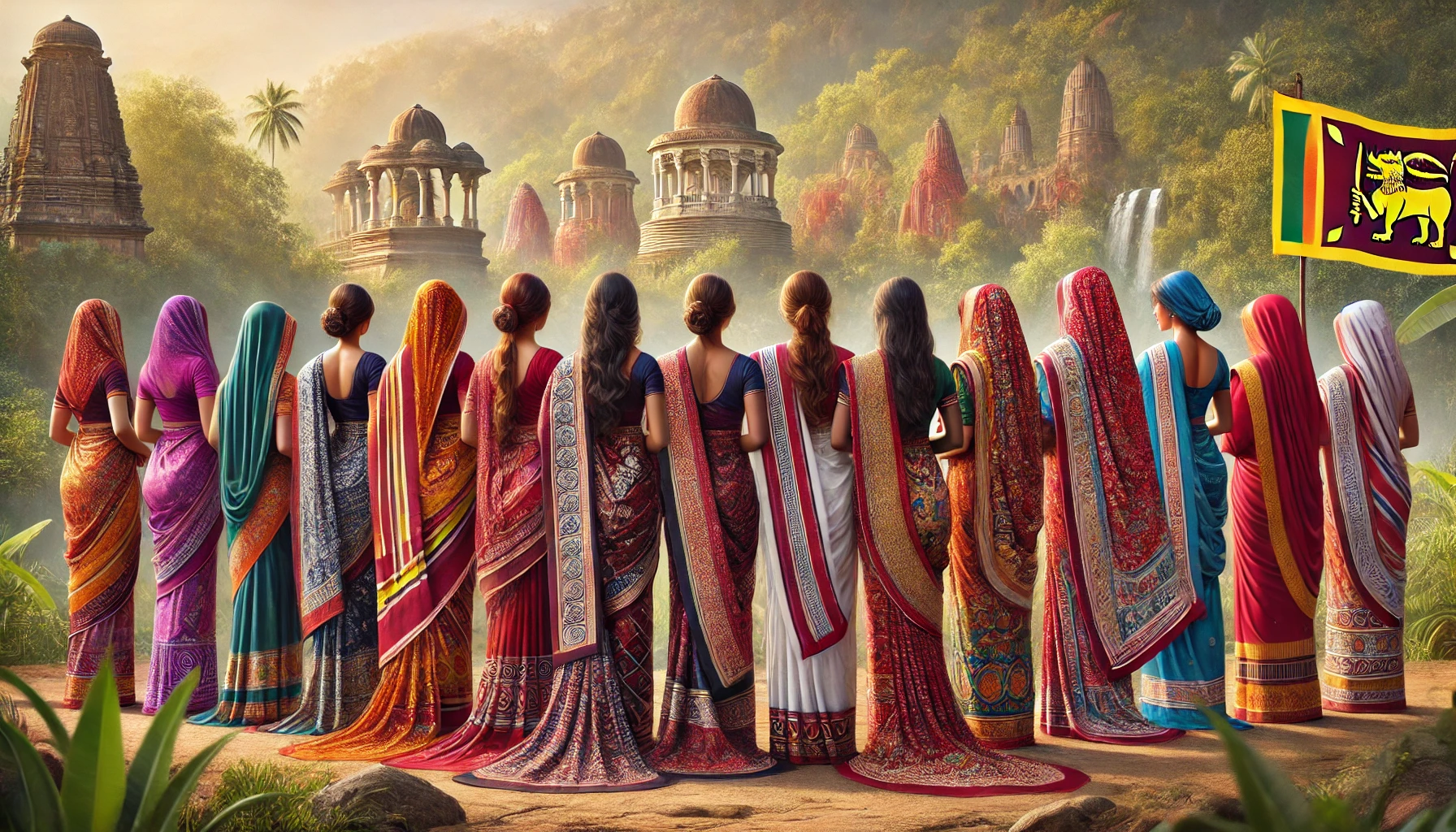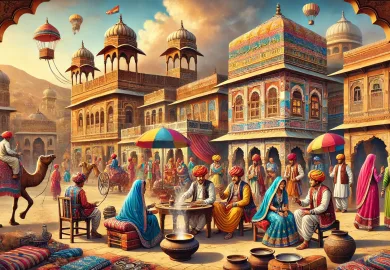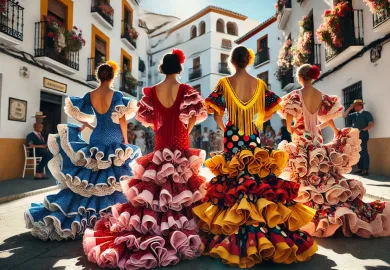
The traditional sari is more than just a garment in Sri Lanka; it is an emblem of culture, identity, and heritage that has gracefully withstood the test of time. Worn primarily by women, the sari is a versatile piece of clothing, showcasing the intricate craftsmanship and vibrant traditions of the island. From everyday wear to ceremonial attire, the Sri Lankan sari holds a place of prominence across all aspects of life, representing a blend of simplicity, sophistication, and a rich cultural narrative. This article delves into the cultural significance, regional variations, and timeless appeal of the traditional Sri Lankan sari.
The Historical Evolution of the Sri Lankan Sari
The sari, a long piece of fabric draped elegantly around the body, has its roots deeply embedded in Sri Lankan history, dating back to ancient times. Although the exact origin of the sari remains somewhat elusive, it is believed to have evolved from the draped garments worn by both men and women in the Indus Valley Civilization, around 2800 to 1800 BCE. The sari, as it is known today, found its distinct identity in South Asia, and Sri Lanka adapted it with its own local flavor over the centuries.
Sri Lanka’s location along the ancient trade routes brought influences from various parts of the world, particularly from India, where the sari has a long history. Early records from travelers and colonial accounts mention the prevalent use of draped garments in Sri Lanka. Over time, the sari became more refined and gained cultural significance, moving beyond just a functional attire to become a symbol of femininity, elegance, and social status.
The influence of the Indian subcontinent is undeniably strong in the evolution of the Sri Lankan sari, particularly in the use of textiles and weaving techniques. However, Sri Lankan saris are distinctive for their regional uniqueness, reflecting the island’s diverse ethnic groups, cultural practices, and local resources.
Different Types of Saris in Sri Lanka: From Kandyan to Contemporary Styles
Sri Lanka boasts a variety of sari styles that reflect the island’s regional diversity and cultural richness. The two most commonly recognized styles are the Kandyan sari and the Indian-style sari, each embodying its own unique identity and significance.
1. The Kandyan Sari
The Kandyan sari, also known as the Osaria, is perhaps the most iconic form of traditional attire in Sri Lanka. Originating from the central highlands, this style is associated with the Kandyan Kingdom, which ruled the island from the late 15th century until the early 19th century. The Kandyan sari is typically worn by Sinhalese women and is easily distinguished by its unique method of draping. Unlike the Indian-style sari, the Kandyan version involves a separate blouse and a more structured way of wrapping the fabric around the waist, with pleats neatly folded in front and a decorative pallu (the draped end of the sari) that is pinned over the left shoulder.
This sari is particularly popular for special occasions, including weddings and formal events. In traditional Sinhalese weddings, brides often wear elaborately decorated Kandyan saris in white or cream shades, adorned with intricate beadwork, embroidery, and gold or silver thread. The Kandyan sari is also the preferred attire for female teachers, politicians, and women in public service, symbolizing grace, dignity, and professionalism.
2. The Indian-Style Sari
While the Kandyan sari is steeped in tradition, the Indian-style sari is more widely worn in contemporary Sri Lanka, especially in urban areas and among the Tamil population. This style is draped differently from the Kandyan version, with the pallu typically draped over the right shoulder, left loose, or styled in various ways. Indian-style saris are often made from a variety of fabrics, including silk, cotton, chiffon, and georgette, offering versatility for both everyday wear and special occasions.
Tamil women, particularly in the Northern and Eastern provinces of Sri Lanka, often wear the Indian-style sari for religious ceremonies, cultural festivals, and weddings. This style is also prevalent among Muslim women in Sri Lanka, who may combine it with a modest blouse and headscarf to align with cultural and religious values. With its ease of draping and wide variety of fabrics and designs, the Indian-style sari has become a popular choice for many modern Sri Lankan women.
3. The Contemporary and Fusion Sari
In recent years, the sari has evolved to embrace more contemporary styles, with designers experimenting with new fabrics, colors, and draping techniques. Younger generations of Sri Lankan women are increasingly drawn to fusion styles that incorporate both traditional elements and modern fashion trends. For instance, some modern saris feature pre-stitched pleats, embellished blouses, and innovative draping methods that make the sari more practical and fashionable for daily wear.
Fusion saris often blend traditional motifs with modern cuts and designs, offering an updated look that appeals to both older and younger generations. Sri Lankan fashion designers have also played a crucial role in popularizing these styles on the global stage, making the sari an iconic garment that transcends borders and continues to evolve with changing times.
The Cultural Significance of Saris in Sri Lankan Society
The sari is not merely an article of clothing in Sri Lanka; it carries deep cultural and symbolic meanings. Across various communities and ethnic groups, the sari serves as a marker of identity, status, and tradition, playing a significant role in both everyday life and important cultural ceremonies.
1. Symbol of Femininity and Grace
In Sri Lankan society, the sari is often associated with ideals of femininity, grace, and modesty. The draping of the fabric, which covers the body while simultaneously accentuating the natural form, creates an elegant silhouette that embodies traditional notions of beauty and decorum. Wearing a sari is often seen as a rite of passage for young women, especially during significant life events such as puberty ceremonies, weddings, and religious functions.
From an early age, Sri Lankan girls are taught the intricacies of sari draping, a skill that is passed down through generations. Mastering the art of wearing a sari is seen as a sign of maturity and womanhood. In many households, mothers and grandmothers take pride in teaching younger family members how to properly wear a sari, ensuring that this cultural tradition is preserved.
2. Status and Social Identity
The type of sari worn, along with the fabric, design, and accessories, can indicate a woman’s social status, profession, and community background. In rural areas, women often wear simple cotton saris for everyday activities, while more affluent women may opt for silk saris embellished with intricate embroidery or zari work for special occasions. Government officials, teachers, and professionals are commonly seen wearing plain-colored saris in their workplace, a nod to the attire’s status as a symbol of professionalism and respectability.
Moreover, certain communities in Sri Lanka have unique ways of wearing saris that reflect their ethnic and cultural identity. For instance, Tamil women in the North and East often wear brightly colored saris with traditional gold jewelry during religious festivals like Thai Pongal and Deepavali, while Muslim women may pair their saris with a hijab for modesty.
3. Ceremonial and Religious Importance
The sari holds particular importance in Sri Lankan religious and ceremonial contexts. For Buddhist women, wearing a white sari during temple visits or religious observances is a common practice. White symbolizes purity and devotion, and it is not uncommon to see women dressed in white saris during Vesak, Poya days, and other significant religious events.
In Hindu temples, Tamil women often wear brightly colored saris to participate in pujas and other sacred rituals, while the sari plays a central role in Hindu wedding customs, where the bride is typically adorned in a resplendent silk sari. Similarly, Muslim women in Sri Lanka incorporate the sari into their religious and family celebrations, often choosing elegant, modest versions that align with cultural expectations of modesty.
Modern Trends and the Global Influence of the Sri Lankan Sari
As the world becomes more interconnected, the traditional Sri Lankan sari has gained global recognition for its beauty, versatility, and cultural significance. Sri Lankan designers, both at home and abroad, are increasingly incorporating the sari into their fashion collections, blending traditional elements with modern aesthetics.
1. Sri Lankan Saris on the Global Stage
The growing influence of Sri Lankan designers in the global fashion industry has brought the traditional sari to the attention of international audiences. Renowned fashion shows, such as Colombo Fashion Week, have featured innovative sari designs that merge traditional craftsmanship with contemporary styles. These saris are often tailored for a global market, with lighter fabrics, minimalistic designs, and bold color combinations appealing to modern fashion enthusiasts.
Sri Lankan expatriates have also contributed to the internationalization of the sari. Whether for religious celebrations or cultural festivals, Sri Lankan communities around the world proudly wear saris, symbolizing a connection to their heritage while also showcasing their traditions on a global stage.
2. Sustainable Fashion and the Revival of Handwoven Saris
As sustainability becomes a key focus in the global fashion industry, there has been a resurgence of interest in handwoven, ethically produced saris in Sri Lanka. Local artisans, especially those from rural communities, are gaining recognition for their craftsmanship, with handloom saris becoming increasingly popular. Handloom weaving is a centuries-old practice in Sri Lanka, and efforts are being made to preserve this tradition by supporting local weavers and promoting their products.
These handwoven saris are not only environmentally friendly but also represent a deeper connection to Sri Lanka’s cultural roots. In a world where fast fashion dominates, the slow, deliberate process of creating handloom saris stands as a testament to the enduring appeal of traditional craftsmanship.
3. The Sari as a Symbol of Empowerment
In contemporary Sri Lanka, the sari has also come to symbolize female empowerment and independence. As more women enter the workforce and take on leadership roles, the sari is often seen as a garment that allows women to embrace their cultural identity while asserting their professional status. Female politicians, business leaders, and public figures frequently wear saris, signaling both their pride in tradition and their confidence in a modern context.
Moreover, fashion designers are increasingly creating saris that cater to women of all body types, making the garment more inclusive and accessible to everyone. The versatility of the sari ensures that it remains a popular choice for women from all walks of life, transcending age, body type, and social status.
Conclusion: The Enduring Legacy of the Sri Lankan Sari
The traditional sari in Sri Lanka is more than just a garment; it is a cultural icon that embodies centuries of history, artistry, and social values. From the regal Kandyan sari to the elegant Indian-style sari, this timeless piece of clothing continues to play a central role in the lives of Sri Lankan women. As fashion trends evolve and global influences shape the industry, the sari remains a symbol of tradition, grace, and empowerment in Sri Lankan society.
Whether worn during everyday activities or as part of grand ceremonies, the sari is a reminder of Sri Lanka’s rich cultural heritage and the enduring beauty of its craftsmanship. The future of the sari looks bright as it continues to adapt and evolve, remaining an integral part of Sri Lanka’s cultural identity for generations to come.








